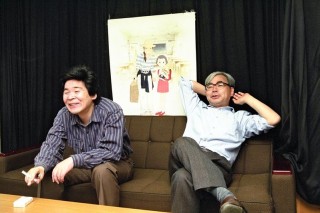Loading
Search
▼ Takahata Elevated Anime as Japanese Culture
- Category:Event
Master director Isao Takahata passed away on Thursday at age 82, leaving significant footprints as a pioneer who had successfully elevated animation — something that had been considered entertainment for kids — to a form of culture representing Japan by tirelessly pursuing how animation can develop as a channel of expression.
Takahata made his debut as a director for feature-length animated movies with the 1968 film “Taiyo no Oji Horusu no Daiboken” (Horus, Prince of The Sun), which was highly acclaimed for introducing viewpoints on social issues in an animation for children, thereby pulling the heartstrings of even adults. Hayao Miyazaki — a young animator back then who is now 77 — also participated in the production of the film.
Takahata established his own style of thoroughly describing people’s daily lives and delicately portraying their minds through the 1974 TV anime series “Arupusu no Shojo Haiji” (Heidi, A Girl of the Alps).
In an unusual move, he himself visited the local areas described in the story and meticulously learned the streetscapes and landscapes. Miyazaki also participated in the trip as a member of the main staff.
In the mid-1980s, Takahata produced two films directed by Miyazaki, “Kaze no Tani no Naushika” (Nausicaa of the Valley of the Wind) and “Tenku no Shiro Rapyuta” (Laputa: The Castle in the Sky). A number of masterpieces were created at Studio Ghibli, the production company established in 1985 mainly by the pair.
While Miyazaki drew animations himself, Takahata focused on dramatics and brushed up themes and expressions.
Deeply knowledgeable about Japanese history and culture, Takahata offered a profound and critical perspective on society in such works as “Hotaru no Haka” (Grave of the Fireflies), the 1988 film he directed based on a story by Akiyuki Nosaka.
The last film he directed was “Kaguyahime no Monogatari” (The Tale of the Princess Kaguya) after spending about eight years on its production. In the film, Takahata described the story by abundantly using images rich in passion and feeling — an endeavor that could be described as “mobile illustrated stories.”
The 2013 film had a high international reputation including a nomination for the Academy Award for best animated feature film.
Takahata also worked hard to introduce talented writers and excellent works from overseas. He served as artistic producer of 2016’s “Red Turtle: Aru Shima no Monogatari” (The Red Turtle), a film Studio Ghibli co-produced with a French film company.
Takahata made his debut as a director for feature-length animated movies with the 1968 film “Taiyo no Oji Horusu no Daiboken” (Horus, Prince of The Sun), which was highly acclaimed for introducing viewpoints on social issues in an animation for children, thereby pulling the heartstrings of even adults. Hayao Miyazaki — a young animator back then who is now 77 — also participated in the production of the film.
Takahata established his own style of thoroughly describing people’s daily lives and delicately portraying their minds through the 1974 TV anime series “Arupusu no Shojo Haiji” (Heidi, A Girl of the Alps).
In an unusual move, he himself visited the local areas described in the story and meticulously learned the streetscapes and landscapes. Miyazaki also participated in the trip as a member of the main staff.
In the mid-1980s, Takahata produced two films directed by Miyazaki, “Kaze no Tani no Naushika” (Nausicaa of the Valley of the Wind) and “Tenku no Shiro Rapyuta” (Laputa: The Castle in the Sky). A number of masterpieces were created at Studio Ghibli, the production company established in 1985 mainly by the pair.
While Miyazaki drew animations himself, Takahata focused on dramatics and brushed up themes and expressions.
Deeply knowledgeable about Japanese history and culture, Takahata offered a profound and critical perspective on society in such works as “Hotaru no Haka” (Grave of the Fireflies), the 1988 film he directed based on a story by Akiyuki Nosaka.
The last film he directed was “Kaguyahime no Monogatari” (The Tale of the Princess Kaguya) after spending about eight years on its production. In the film, Takahata described the story by abundantly using images rich in passion and feeling — an endeavor that could be described as “mobile illustrated stories.”
The 2013 film had a high international reputation including a nomination for the Academy Award for best animated feature film.
Takahata also worked hard to introduce talented writers and excellent works from overseas. He served as artistic producer of 2016’s “Red Turtle: Aru Shima no Monogatari” (The Red Turtle), a film Studio Ghibli co-produced with a French film company.
- April 7, 2018
- Comment (0)
- Trackback(0)


